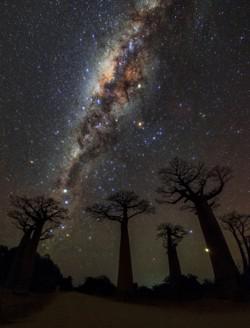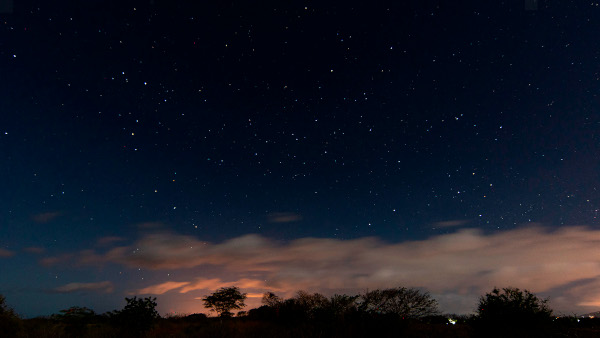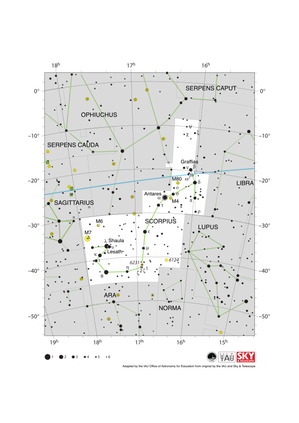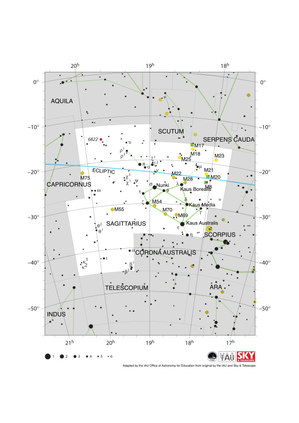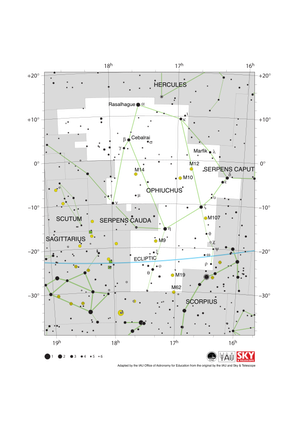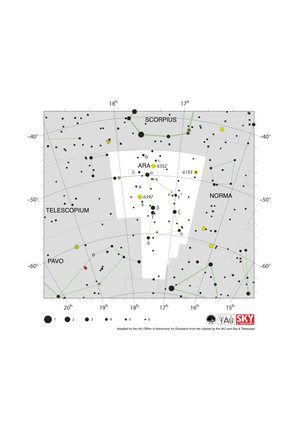Glossary term: Scorpius
Description: Le Scorpion est l'une des 13 constellations du Zodiaque. Les étoiles qui composent cette constellation se trouvent dans la partie du ciel qui croise l'écliptique (le plan défini par la trajectoire de la Terre autour du Soleil). En fait, toutes les constellations qui composent le Zodiaque croisent l'écliptique. Depuis la Terre, on trouve régulièrement le Soleil, ainsi que les autres planètes du système solaire, dans la constellation du Scorpion. Il s'agit de l'une des 88 constellations reconnues par l'Union astronomique internationale. Le Scorpion est également l'une des 48 constellations originales identifiées par Ptolémée ; il avait été identifié par les Sumériens plus d'un millier d'années avant lui. D'autres cultures ont donné des noms différents au Scorpion : il est connu sous le nom de Crochet de Maui dans les cultures Māori et polynésiennes, et des groupes indigènes australiens comme le peuple Yolngu de la Terre d'Arnhem identifient le Scorpion comme étant à la fois un crocodile et un scorpion. L'étoile la plus brillante de la constellation est Antarès (connue sous le nom d'alpha Scorpii), une étoile géante rouge située à environ 550 années-lumière de la Terre.
Related Terms:
See this term in other languages
Term and definition status: The original definition of this term in English have been approved by a research astronomer and a teacher The translation of this term and its definition is still awaiting approval
The OAE Multilingual Glossary is a project of the IAU Office of Astronomy for Education (OAE) in collaboration with the IAU Office of Astronomy Outreach (OAO). The terms and definitions were chosen, written and reviewed by a collective effort from the OAE, the OAE Centers and Nodes, the OAE National Astronomy Education Coordinators (NAECs) and other volunteers. You can find a full list of credits here. All glossary terms and their definitions are released under a Creative Commons CC BY-4.0 license and should be credited to "IAU OAE".
If you notice a factual or translation error in this glossary term or definition then please get in touch.
Related Media
Voie lactée au-dessus de l'Avenue des Baobabs
Credit: Amirreza Kamkar/UAI OAE
License: CC-BY-4.0 Creative Commons Attribution 4.0 International (CC BY 4.0) icons
Conduire
Credit: Marcin Zajac/IAU OAE
License: CC-BY-4.0 Creative Commons Attribution 4.0 International (CC BY 4.0) icons
Voie lactée sur le parc national d'Amboseli
Credit: Amirreza Kamkar/UAI OAE
License: CC-BY-4.0 Creative Commons Attribution 4.0 International (CC BY 4.0) icons
La Voie lactée à travers le zénith
Credit: Ohnishi Kouji/UAI OAE
License: CC-BY-4.0 Creative Commons Attribution 4.0 International (CC BY 4.0) icons
Sky Over the Town of Nindirí, in Masaya, Nicaragua
Credit: René Antonio Urroz Álvarez/IAU OAE
License: CC-BY-4.0 Creative Commons Attribution 4.0 International (CC BY 4.0) icons
Related Diagrams
Libra Constellation Map
Credit: Adapted by the IAU Office of Astronomy for Education from the original by IAU/Sky & Telescope
License: CC-BY-4.0 Creative Commons Attribution 4.0 International (CC BY 4.0) icons
Scorpius Constellation Map
Credit: Adapted by the IAU Office of Astronomy for Education from the original by IAU/Sky & Telescope
License: CC-BY-4.0 Creative Commons Attribution 4.0 International (CC BY 4.0) icons
Sagittarius Constellation Map
Credit: Adapted by the IAU Office of Astronomy for Education from the original by IAU/Sky & Telescope
License: CC-BY-4.0 Creative Commons Attribution 4.0 International (CC BY 4.0) icons
Ophiuchus Constellation Map
Credit: Adapted by the IAU Office of Astronomy for Education from the original by IAU/Sky & Telescope
License: CC-BY-4.0 Creative Commons Attribution 4.0 International (CC BY 4.0) icons
Ara Constellation Map
Credit: Adapted by the IAU Office of Astronomy for Education from the original by IAU/Sky & Telescope
License: CC-BY-4.0 Creative Commons Attribution 4.0 International (CC BY 4.0) icons
